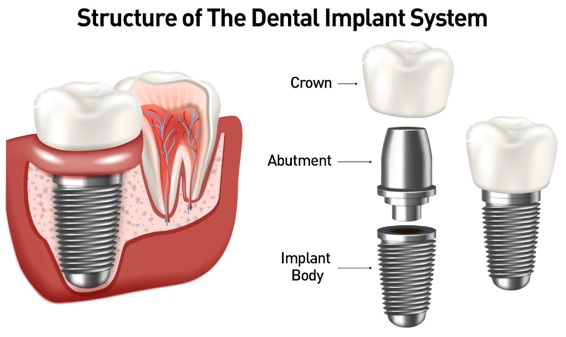The Definitive Guide to Dental Implants
Table of ContentsThe Ultimate Guide To Dental ImplantsNot known Details About Dental Implants Dental Implants Things To Know Before You BuyWhat Does Dental Implants Mean?
are medical gadgets operatively dental implanted into the jaw to bring back a person's capability to eat or their appearance. They supply support for fabricated (fake) teeth, such as crowns, bridges, or dentures. When a tooth is lost because of injury or illness, a person can experience problems such as fast bone loss, malfunctioning speech, or modifications to chewing patterns that lead to discomfort.
Structure of The Dental Implant System selecting oral implants, talk to your dental company regarding the prospective advantages and risks, and whether you are a candidate for the treatment. Points to consider: Your overall health is a vital element in figuring out whether you are a good candidate for dental implants, for how long it will take to recover, and for how long the dental implant may remain in place.
Smoking cigarettes may influence the healing process and reduce the long-lasting success of the implant. The healing process for the dental implant body may take several months or longer, during which time you generally have a short-lived joint instead of the tooth. the oral implant treatment: Very carefully adhere to the oral hygiene guidelines offered to you by your dental service provider.
How Dental Implants can Save You Time, Stress, and Money.
Implant failing can result in the requirement for an additional procedure to fix or replace the dental implant system. Recovers the ability to chew Brings back cosmetic look Helps maintain the jawbone from diminishing as a result of bone loss Maintains the wellness of the bordering bone and gum tissues Aids maintain nearby (nearby) teeth steady Boosts lifestyle Damage to bordering all-natural teeth throughout implant placement Injury to the surrounding tissues throughout surgery, such as sinus opening Injury throughout surgery (as an example, fracture of bordering jawbone) Inadequate function, such as really feeling like the teeth do not attack together generally A feeling that the tooth is loose or turning in place resulting from a joint screw loosening up Implant body failure (looseness of the dental implant body) due to systemic infection, which may be more probable in individuals with unchecked diabetes mellitus due to regional infection in bone and periodontals supporting the implant body due to postponed healing, which may be much more most likely in people that smoke Difficulty cleansing the periodontals around the dental implant, causing inadequate oral hygiene Untreated periodontal illness Post-surgical pins and needles because of nerve impingement or damages Always notify health treatment companies and imaging professionals that you have oral implants prior to any magnetic resonance imaging (MRI) or x-ray procedures.
FDA is not familiar with any kind of damaging occasions reported for MRI or x-ray treatments with oral implants. Dental implants systems are typically made of products that adhere to worldwide consensus standards of the International Organization for Standardization (ISO) or ASTM International. These criteria have information of what makes a secure product.
Oral dental implant systems are assessed according to global agreement standards. Biocompatibility screening, to reveal that physical contact with the gadget does not cause issues like inflammation or allergic response, is part of the examination that aids make certain the materials in the oral implant system are secure and do not create damaging results when implanted in people.

The 6-Minute Rule for Dental Implants
Some individuals are not eligible for oral implant surgical procedure. It is for oral cosmetic visit this website surgeons to run on people with: severe illnessuncontrollable metabolic diseasebone or soft tissue disease or infectionIf these issues are settled, a person can have the surgery. Dental Implants. In, dental cosmetic surgeons avoid running on individuals with: If individuals with any of the above undertake oral implant surgical procedure, there is a greater threat of the dental implant failing
Some individuals have a jawbone abnormality that stops enough bone for a dental implant from creating. The specialist will certainly after that make use of a bone or bone substitute to fix and build up the area.
Oral implant surgery is a customized process. It's not the very same for everyone. But the adhering to offers a basic overview of what you can expect your dental expert, oral doctor, periodontist or prosthodontist to do: Put the implant surgically. Offer you time to heal. Connect the post and last crown, bridge or denture.
Next, your cosmetic surgeon will view website carefully put the dental implant into your jaw. Finally, your surgeon will rearrange your periodontals and close the incision with stitches. If your implant is near the front of your mouth, your dental expert will make a short-lived tooth for you to use up until you recover. That method, you will not have a space in your smile while you recuperate.
Excitement About Dental Implants
Your copyright can inform you what to anticipate in your situation. Throughout the healing stage, your jawbone should fuse to the oral implant. This process, called osseointegration, is important for stability and long-term success. This procedure can take anywhere from 3 to 9 months. In some cases, it may take much longer.
Once your implant heals, your dental expert can attach the joint (tiny port message) and your last restoration (crown, bridge or denture). This generally takes concerning one hour to finish and may need a second minor surgery. You should not feel any type of discomfort throughout your oral implant procedure due to the fact that your provider will certainly make use of medicine to numb your periodontals.